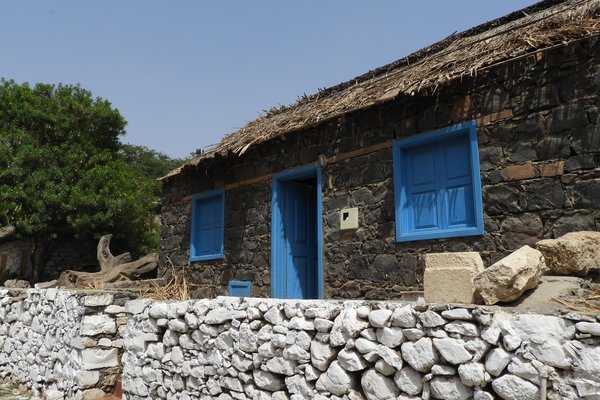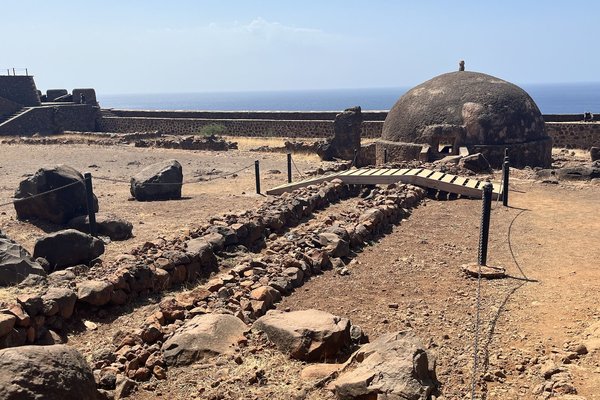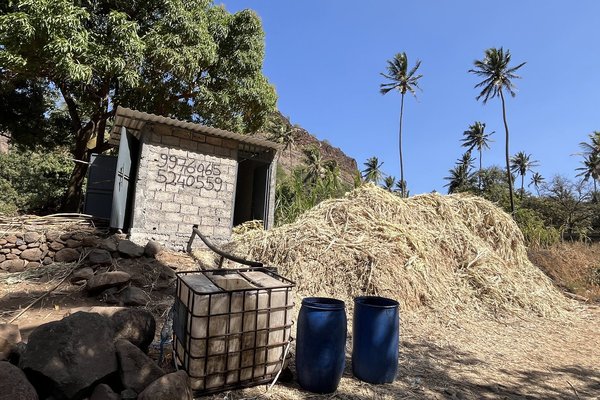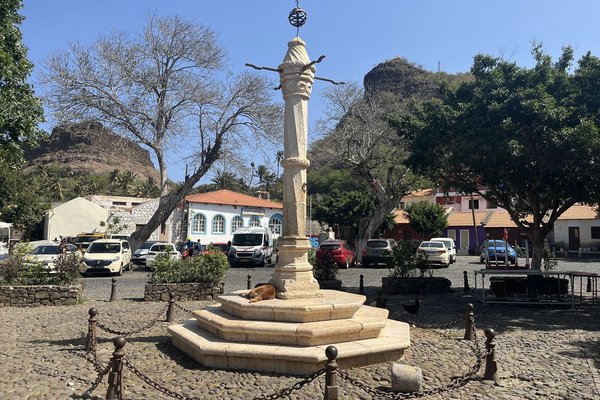Cabo Verde
Cidade Velha
Cidade Velha, Historic Centre of Ribeira Grande, was a Portuguese colonial settlement that played an important role in the maritime trade of enslaved persons and goods between Europa, Africa and America.
The enslaved were also used to further develop the local colony, which resulted in the birth of Creole culture. Surviving monuments in Cidade Velha from that period include the oldest colonial church in the world, constructed in 1495, and Pillory Square with its ornate 16th-century marble pillar.
Community Perspective: situated on Cabo Verde’s main island, Santiago and only 15 km outside of the current capital, the town is easy to reach. Reviewers found no great deal to see, the best-preserved monument being the Fort Real of Sao Filipe, and compared the atmosphere to “a sleepy African, or perhaps more specifically, Brazilian village”. Els explored the Ribeira Grande Valley, also part of the inscribed site, on foot.
Site Info
Official Information
- Full Name
- Cidade Velha, Historic Centre of Ribeira Grande (ID: 1310)
- Country
- Cabo Verde
- Status
-
Inscribed 2009
Site history
History of Cidade Velha
- 2009: Advisory Body overruled
- ICOMOS suggested Referral, but WHC decided to Inscribe
- 2009: Inscribed
- Inscribed
- 1992: Rejected
- No protection and does not justify WHS
- Type
- Cultural
- Criteria
- ii
- iii
- vi
Links
- UNESCO
- whc.unesco.org
- Related
-
- youtube.com — Series of YouTube videos made by Cambridge University during their Cabo Verde research
All Links
UNESCO.org
- whc.unesco.org — whc.unesco.org/
Related Resources
- youtube.com — Series of YouTube videos made by Cambridge University during their Cabo Verde research
News Article
- Nov. 7, 2015 phys.org — Earliest church in the tropics unearthed in former heart of Atlantic slave trade
Community Information
- Community Category
- Urban landscape: Colonial
Travel Information
Recent Connections
-
Sahel
"Cape Verde is part of the Sahelian sem… -
Named after a River
Ribeira Grande "The freshwater coastal … -
Destroyed during invasion
Ruínas da Catedral da Ribeira Grande de…
Connections of Cidade Velha
- Individual People
-
-
Christopher Columbus
Stopped off here -
Vasco da Gama
Stopped off here -
Magellan
visited 1519 -
Charles Darwin
Visited it during his voyage Jan 1832See media.isnet.org
-
Sir Francis Drake
Attacked it
-
- Geography
-
-
Sahel
"Cape Verde is part of the Sahelian semi-arid belt, with nothing like the rainfall levels of nearby West Africa." (wiki)See en.wikipedia.org
-
Atlantic Ocean
"testimony to its considerable role in international trade associated with the development of European colonial domination towards Africa and America and the birth of Atlantic triangular trade" (OUV) -
Macaronesia
Lies on Santiago Island, one of The Cape Verde islands that form part of the Macaronesia ecoregion -
Situated in one of the SIDS
Cape Verde 2009
-
- Trivia
-
-
Built or owned by Portuguese
Fort Real de Sao Filipe (1590)
-
- History
-
-
Located in a Former Capital
Capital of Portuguese colony (as Ribeira Grande), moved to Praia in 1770 -
Sieges and Battles
Capture of Santiago (1585)See en.wikipedia.org
-
- Architecture
-
-
Gothic
Igreja de Nossa Senhora do RosárioSee en.wikipedia.org
-
Vernacular architecture
Rua da Banana -
Manueline style
The pillory
-
- Damaged
-
-
Destroyed during invasion
Ruínas da Catedral da Ribeira Grande de Santiago - destroyed during "a major attack carried out by the French privateer, Jacques Cassard, in 1712".See ipc.cv
-
- World Heritage Process
-
-
Ten years or more to inscribe
1992-2009 -
Slow Starters
1988-2009 : 21 years -
Rejected, and then inscribed
Rejected quite conclusive in 1992 -
First inscriptions
Cabo Verde 2009 -
Only WHS in their country
Cabo Verde
-
- Religion and Belief
-
-
Franciscan Order
Convento/Igreja de São FranciscoSee ipc.cv
-
Cathedrals
Sé Catedral (ruins)
-
- Human Activity
-
-
Piracy
"The riches of Ribeira Grande and conflicts between Portugal and rival colonial powers France and Britain attracted pirate attacks, including those by Francis Drake (1585) and Jacques Cassard (1712)." (wiki)See en.wikipedia.org
-
Slavery
Important port in the transcontinental slavery -
Sea Ports
"the bay, which constitutes a naturally sheltered port" (AB ev)
-
- Constructions
- Timeline
-
-
Built in the 15th century
"The island of Santiago was discovered around 1460 and claimed for the Crown of Portugal. There was no human presence on the island..... As early as 1466 it was granted a royal charter entitling its inhabitants to practise the slave trade.... Ribeira Grande was the first European town to be built in the tropics, from the end of the 15th century onwards... Construction of the first defensive structures, the town hall, and the first church began at the end of the 15th century" (AB)
-
- WHS Names
-
-
Named after a River
Ribeira Grande "The freshwater coastal river, which gave the town its original name" (AB ev) - the river bed nowadays is often dry
-
News
- phys.org 11/07/2015
- Earliest church in the tropics une…
Recent Visitors
Visitors of Cidade Velha
- aj
- Alexander Barabanov
- A. Mehmet Haksever
- Artur Anuszewski
- Ask Gudmundsen
- Bill Maurmann
- Bram de Bruin
- Christoph
- Christravelblog
- Daniel Gabi
- Dimitar Krastev
- Els Slots
- Emili Xaus
- Eva Kisgyorgy
- Gernot
- Hadrianus
- Harry Mitsidis
- Iain Jackson
- Jana and Matt
- Janos
- João Aender
- jonathanfr
- Jon Opol
- jxrocky
- Kevin247
- Lado Joel
- Loic Pedras
- Luis Filipe Gaspar
- Maciej Gil
- Mahuhe
- marcel staron
- Mariam
- Michael Novins
- Mikko
- Nick Kuzmyak
- Nick M
- Persian Globetrotter
- petar
- Philipp Leu
- Pierre T
- Potsdamer
- Randi Thomsen
- Reisedachs
- Roger Ourset
- Roman Bruehwiler
- Solivagant
- Stanislaw Warwas
- Stijn
- Svein Elias
- Szucs Tamas
- Thomas Buechler
- tony0001
- Vanessa Buechler
- Weecheng
- Wojciech Fedoruk
- Wo_ko
- Yongcheng Liu
Community Reviews
Show full reviews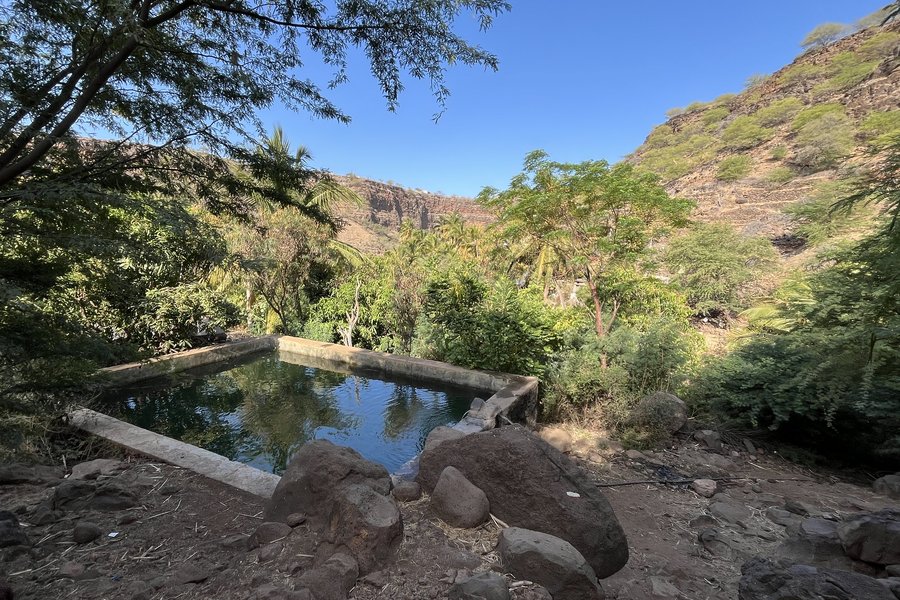
Cidade Velha is an easy, short excursion from Santiago’s (and Cabo Verde’s) capital Praia. A bay, a few cobbled streets, remains of Portuguese fortifications and churches – you know what it looks like even before you have seen it. I tried a different approach for my visit and went for a guided hike through the Ribeira Grande Valley. This way I also ticked one of the other activity boxes I had for Cabo Verde: “Do a hike in the countryside” (as the archipelago is known as a hiker's paradise).
When you look at the official map of Cidade Velha WHS, you’ll notice that not only the seaside town is included but also a much larger area inland. The boundaries of the core zone follow the canyon that was carved out by the river Ribeira Grande. This area is linked to a specific part of the site’s OUV: the “acclimatisation and dissemination of numerous plant species between the temperate and tropical zones”. The Portuguese colonists experimented with various crops here in the 16th and 17th centuries, starting unsuccessfully with cereals but later finding out that plants from Africa’s mainland (coconut) and Latin America (maize) did well.
We started our hike in the village of Calabaceira. From there, a marked trail leads down into the valley. The guided hike is labelled as “an easy and accessible path for every hiker” by the tour company, but the volcanic soil is rocky all the time and especially when going down, you have to stay …
Keep reading 0 comments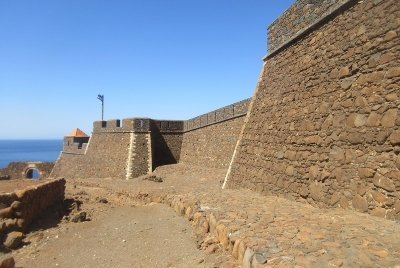
It seems Cape Verde is not a very popular country in this community. It is not surprising since there is only one World Heritage Site and chances for the inscription of the second one (Tarrafal) are vague. But if you do not follow typical beach vacation on Sal or Boa Vista, there is a lot to see and there is a surprising variety of landscapes in this small country.
Cidade Velha, the only WHS of the country, was the first settlement of the archipelago and the first colonial town south of Sahara. The Portuguese, striving for piety up to exaggeration, built here more churches than secular buildings. Some of them, such as Convent of Sao Francisco, or Church of Nossa Senhora do Rosario (the oldest colonial church in the world) are part of the inscription. The other one – Se Cathedral (again the first colonial cathedral) is nowadays nothing but ruins. All inscribed properties are withing the walking distance and can be convered in a couple of hours. The best preserved is Fort Real of Sao Filipe, a stronghold built on the steepy hill nearby (the pave is very bad and we almost surrendered descending it with baby stroller).
Cidade Velha lost competition with Praia and now is nothing but a small but nice village, perfect for a half a day trip from the capital. After visiting the inscribed sites it is worth to sit in one of the restaurants in the center, with a sea view from …
Keep reading 0 comments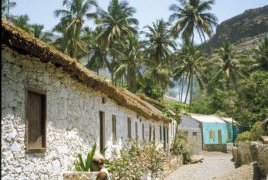
So Durian’s “inside information” suggests that “Cidade Velha, Ancient Ribera Grande” in Cape Verde might be proposed for inscription in 2009 (see Forum “Nominations for 2009”). For the benefit of my “Visited count” I certainly hope so, since I visited it in April 2003 – but without any expectation that it might EVER be a WHS! In fact Cape Verde only got round to proposing a T List in 2004. Interestingly, however, this small island country had tried to get this very site inscribed many years earlier. I quote verbatim the minutes of the Bureau meeting at Paris in July 1992 “The Bureau considered that, in spite of its indisputable historic value, the property did not meet the criteria for inscription on the World Heritage List”. And at the WHC itself at Santa Fe in December 1992 “The Committee noted that there was no protection or management plan for this cultural property and that it did not meet the criteria for inscription on the World Heritage List”. Well that’s pretty clear then isn’t it! But, as we have noted before, “No” doen’t have to mean “No” where the WHC is concerned! Political imperatives can change a “no hoper” into a “star” and a bit of coaching in the preparation of good (and voluminous) documentation from experts in the field can help overcome doubts!
Well – what is there at Cidade Velha? It is situated on Sao Tiago, the largest island of the Cape Verde …
Keep reading 0 comments
